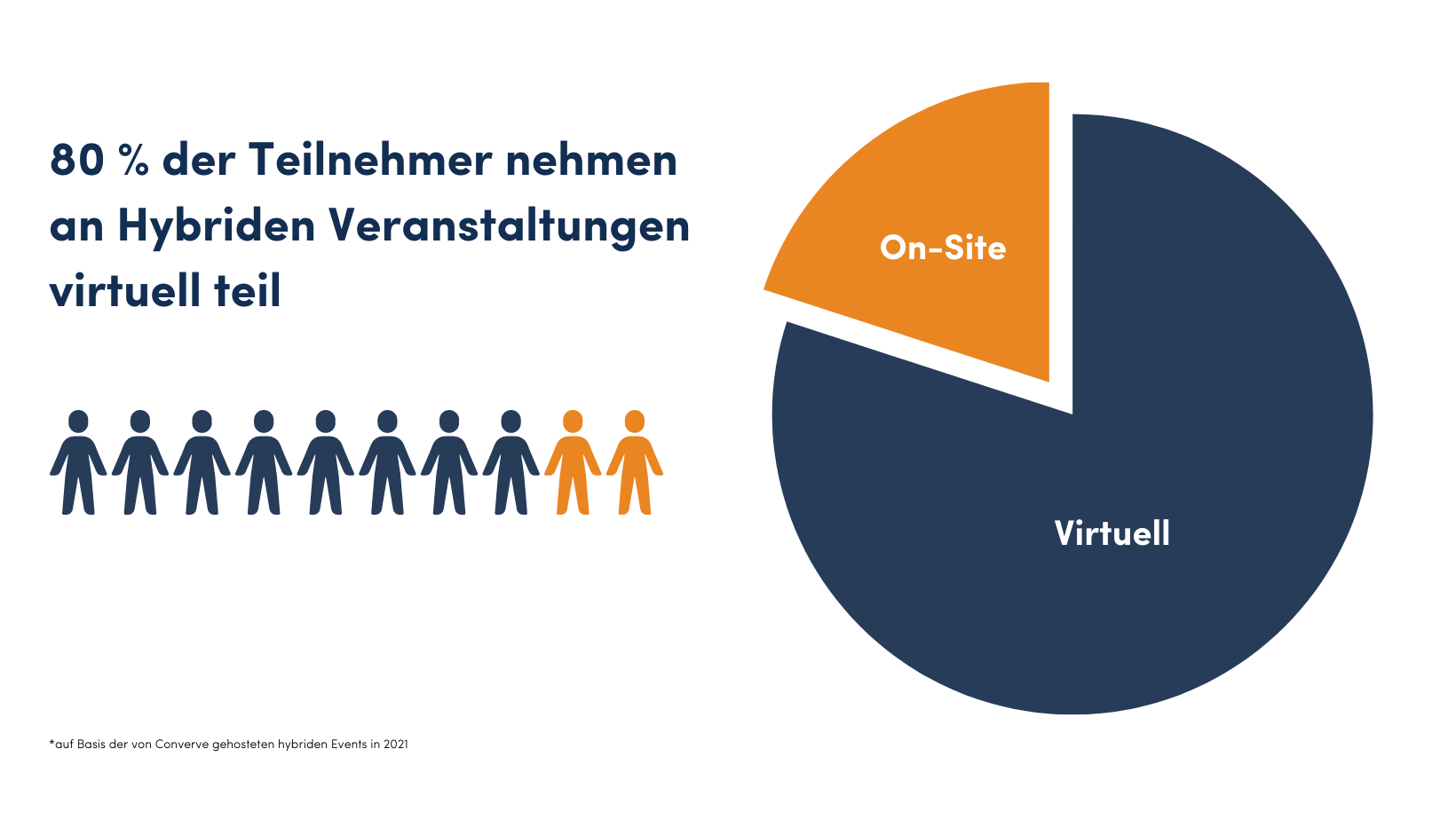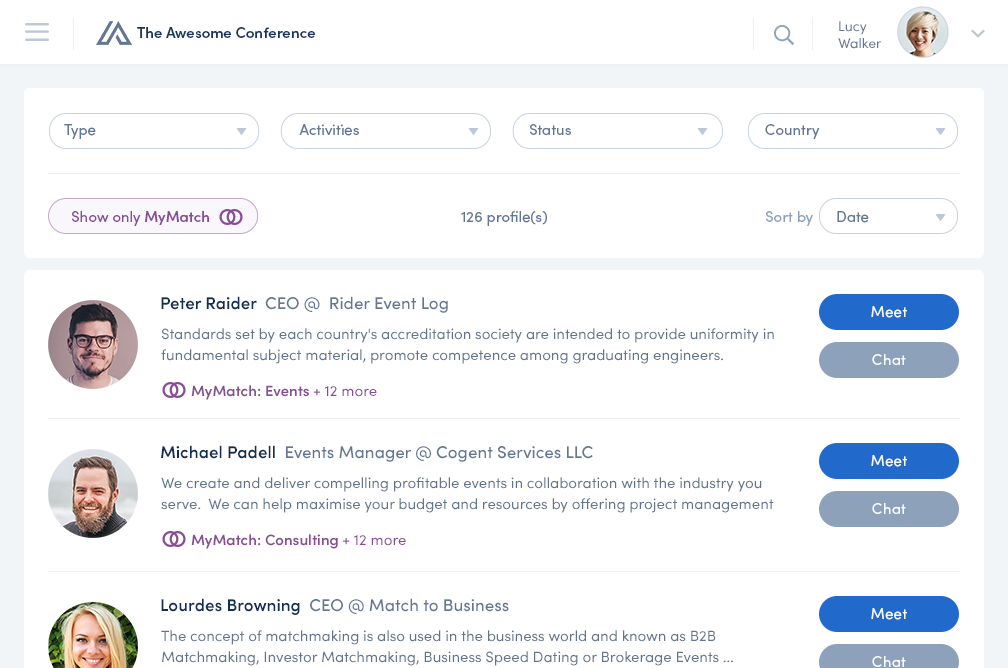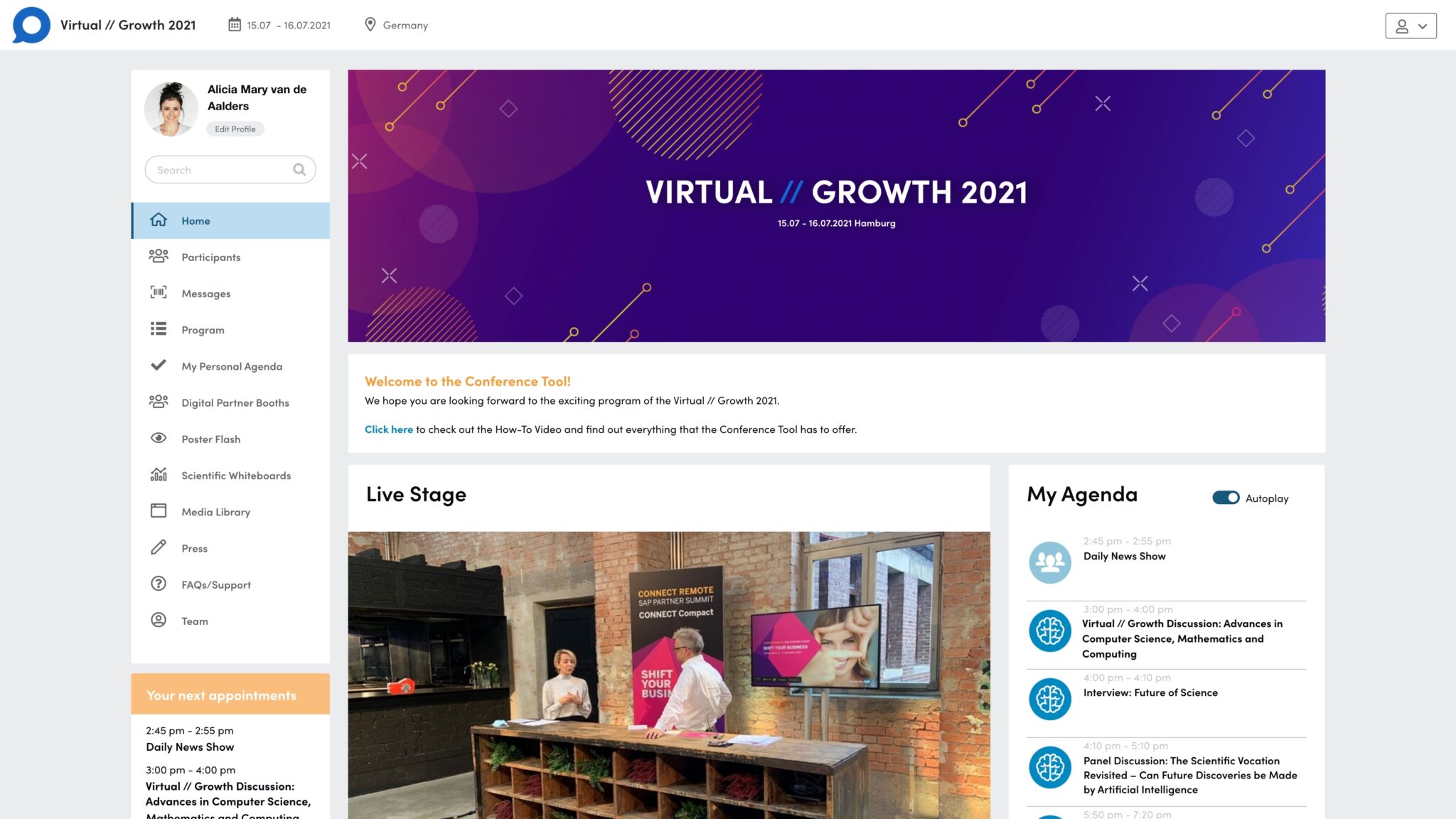Terms like ” hybrid event” or “hybrid event platform” are coming up more and more often lately when it comes to planning events. Are they the “new normal” and how can you successfully plan a hybrid event?
Definition: What are hybrid events?
Hybrid events combine the best of two worlds. Hybrid means “mixed” and represents the combination of a physical face-to-face event (live event) and a virtual event.
The most important thing you need for this is a stable internet connection and suitable technical equipment. Both types of events – hybrid or live event – pursue the same goal: people should be able to network with each other.
As a result, a hybrid event is not simply a synonym for a livestream. Online attendees should be an active part of the event. This ranges from interactive live events to the use of event apps, AR or VR applications and formats that are reminiscent of interactive television.
Hybrid event example:
Due to Corona contact restrictions, no large “get-togethers” are allowed. The organiser considers a hybrid version of his event and invites the most important participants on site to listen to interesting speakers. For the rest of the participants, the talks will be simultaneously broadcast online. Afterwards, meeting points and discussion rounds are organised together for online and offline attendees.
Are hybrid events really the future?
“Hybrid events are the future”. This slogan can now be read everywhere in the event industry. But is it really true? The Corona crisis has greatly accelerated the spread of hybrid events. According to the Meeting and Event Barometer 2020/2021, hybrid events increased by 54% in 2020.
But even before the pandemic, events were becoming increasingly digital. According to the GCB, 60% of the suppliers surveyed in March 2020 already considered hybrid or virtual events to be trend-setting.
Corona has therefore not triggered the digitalisation of the event industry, but rather accelerated it. It is clear to most event planners that there will no longer be a return to purely offline structures in event management. Physical B2B event formats will also be increasingly supplemented by digital elements in the future.
Why is that the case? Hybrid events offer many advantages that organisers and participants will not want to miss in the future. Find out what these are in the following.
What are the advantages and disadvantages of hybrid events?
Wouldn’t we all want to attend events much more often? However, it takes a lot of effort to be present at an event. The digital extension in event management is an optimal tool to reach a larger group of participants. And not only that! Hybrid event formats offer completely different advantages. Learn about the new opportunities and challenges, but also the possible disadvantages in an increasingly digital world of event planning.
Advantages of hybrid events
Wider reach and more attendees: A purely in person experience or live event often leads to limitations in terms of venue size and number of attendees. With hybrid events, you can reach a large virtual audience and maximise your reach and the impact and success of your event. Furthermore, you can have speakers from all over the world participate in your event, which would not be possible with physical events.

Lower event costs: Physical events come at a significant cost and the more people that attend your event, the more expensive it becomes. Just think of travel costs, venue costs, catering and much more. With hybrid events, you can keep your costs in check by reducing the number of on-site event attendees.
Higher audience engagement: Another advantage of hybrid events is the more extensive audience engagement. Virtual components not only give you new opportunities to actively engage participants during the event, but also for days and weeks after the event. Virtual attendees can comment, ask questions, share and like, and interact with other participants from their smartphones, tablets or computers. In person attendees can also network with virtual attendees and participate in the online activities. This works best via a hybrid event platform that connects virtual and in person participants.
More sponsorship opportunities: The wider reach of virtual and hybrid events also makes you more attractive to sponsors, as you can reach a larger audience. Sponsors have the opportunity to participate in the event by setting up virtual booths and possibly giving presentations via video conferencing
Lower carbon footprint: According to atmosfair, travelling to and from events causes about 70% of the CO₂ emissions of an entire event. By organising a hybrid event, you can significantly reduce the CO₂ emissions of the event. Take advantage of hybrid events to make your trade fair or event more sustainable and reduce your environmental footprint.
Event Marketing opportunities through reporting and analysis: Data, Data, Data. Hybrid events allow you to better capture, analyse and use data for your event marketing. For example, you can use a professional hybrid event platform to track which aspects of the event particularly impressed the audience and which services they used more of. Use this knowledge to create an effective marketing campaign for your next event.
Democratisation of events: Because participants in hybrid events can also attend from distant regions that would never have been able to attend their live events, access to knowledge and networks is democratised with the help of hybrid events. You also offer acces to more knowledge and contact to virtual attendees who cannot afford to be away for several days, such as parents.
These are the challenges you have to face with hybrid events
Higher organisational effort: You are organising an event on two levels. Of course, in the simplest case you can set up a camera, but in very few cases this meets the requirements of a hybrid event. Event guests and planners know: it can be done much better and tools also help with interaction and networking in the digital space.
Initial investment costs: To hold a hybrid event, you need the right technology and preferably a tool for hybrid events. Therefore, you have to expect some investment costs at the beginning.
Higher demands for creative concepts: The demands on creative concepts double when online and offline worlds merge. You cannot transfer the event plan from the physical 1:1 to the virtual world. New content ideas are needed to keep the attention of virtual audiences.
More Complex Processes : As you are actually planning two events, the complexity of the processes increases. All information needs to be adapted and sent to both groups of participants. Both groups may need a different kind of support. A professional attendee management supports you effectively.
Technical know-how: The staff must be familiar with the technology, e.g. how the live stream is produced and streamed, answer technical system questions and be able to deal with virtual communication and user interaction.
Transporting emotions: As an event manager, you must ensure that the content of your event is designed to create just as much emotion and experience in the virtual space and on the stage. Make sure you leave enough space for networking and interaction. Less but good content will enhance your event format.
9 Hybrid Events Tips: Do’s and Don’ts
If you want to plan hybrid events yourself, then make use of our tips and successfully launch into a new era of event planning.
Do this when planning hybrid events
1. Use the right technology
There are many hybrid event platforms in the market recently. Online & virtual event platforms make your hybrid event more professional and help you with planning, communication and reporting. However, make sure that the selected providers really have experience and ask them to show you reference projects.
2. Provide spaces for interaction
Plan interactions, breakouts and deliberate involvement of participants online as well as offline. Good interactions reinforce the key points of the event programme and create experiences and excitement for the virtual and live audience. You can also create virtual interactivity with quizzes, surveys, matchmaking or chat modules, to name just a few.
3. Make sure there is variety
You don’t want your audience to be bored in front of the screen. Therefore, make your hybrid event as exciting as possible. Interviews, moderated talks, (short) keynotes, videos, quizzes, Q&A sessions are some options. Don’t be afraid to include the virtual participants in front of the screens for the live audience.
4. Onboarding and final rehearsal
Hybrid events are still in their early stages. Make sure that everything works properly before the start of your event. Use the right tools and test them intensively! Not every staff member and participant is familiar with the hybrid event model and technology. This is especially true for speakers and moderators. Before any virtual event, you should not only test the technology together, but also communicate what makes the experience in virtual formats.
5. Presentation
A moderator provides a link between the two worlds and gives a consistent theme that guides the participants across the platform and through the event. Make sure that people that attend in person as well as people attending virtually both get the moderators attention. Your moderator needs to make sure that remote attendees stay engaged with your steam. Interaction with the live stream chat has proven to be incredibly valuable for this purpose.
6. Take time zones into account
Be aware that your participants may come from different time zones. Therefore, it is important that the event platform you use can map this requirement. It is ideal if the participant can set the time zone in which they are attending your event themselves and can also see when, for example, an agreed appointment is taking place in the time zone of the person they are talking to.
Don’t do this when planning hybrid events
7. Transfering a live event to the virtual space
You need to come up with new concepts for online events: snackable content, short thematic blocks and changing impulses extend the attention span. Ask yourself the following question: How can both your in person and virtual attendees be involved in the same way and how can the exchange be organised?
8. Saving on audio and video equipment
Good audio and video equipment for e.g. live streams is essential for virtual and hybrid events. If there is a lack of quality here, you will quickly lose your participants. Use the right tools and be sure to test them beforehand.
9. Tieing the duration to your in person event
Participating with headphones and looking at the screen is tiring and much more exhausting than an on-site event. Therefore, keep an eye on the time and adapt the total duration of the event to the virtual event. Six hours is the upper limit.
Summary: Hybrid events as an opportunity for new concepts and more reach
Hybrid events will become more and more common in the future, as the advantages of this event form cannot be denied. Use the opportunity to win over an even larger target group with new concepts and content and sophisticated digital marketing strategies.
The challenge of hybrid events is to meet the needs of both online and offline participants and to build bridges between live and digital audiences
This is possible by using professional hybrid event platforms like Converve. Converve is an all-in-one platform: whether it’s an easy-to-create event website, event app, networking, matchmaking or collection valuable data through reporting – everything is combined in just one tool.
Are you planning your next hybrid event or just want to know more about us? Contact us now! We look forward to answering your questions





